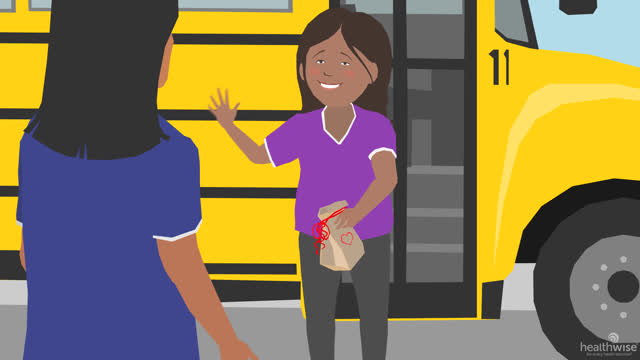Top of the pageActionset
Diabetes in Children: Preparing a Care Plan for School
Introduction
A diabetes care plan will help your child’s teachers and other school staff know when and how to manage your child’s diabetes. For example, if your child needs to eat shortly after taking insulin or to have a snack in class, then a teacher or other adult can make sure that this happens.
At the same time, the teacher will know not to make your child stand out as “the kid with diabetes.” Your child may also feel better knowing that his or her teachers or other school staff can help when needed.
It’s a good idea to meet with the school staff, including the principal, teachers, coaches, bus driver, school nurse, and lunchroom workers, before your child starts school and at the beginning of each school year. Update the plan each year before school starts, and tell the school staff about any changes to the plan.
- The goal of a diabetes care plan for school is to meet your child’s daily needs and prepare ahead of time for any problems. This means including all the information that the school staff needs to know to make sure your child’s diabetes is under control.
- A diabetes care plan for school should include medical information as well as other information that the school staff needs to know, including emergency contacts, when to call the parents, and food information.
- Children with diabetes want to fit in with their classmates as much as possible. A diabetes care plan can also address how to handle special occasions, such as a school party or field trip, so your child won’t feel left out.
How do you make a diabetes care plan for school?
A diabetes care plan lists all the information that the school staff needs to know to make sure your child’s diabetes is under control. Be sure to write down information about:
- Insulin, if needed. Include information on how to give insulin to your child, how much insulin to give, and how to store the insulin. Your child may get it as a shot, use an insulin pen, or have an insulin pump.
- Other medicine. If your child takes other medicine for diabetes, make sure you include instructions on how, when, and how much medicine your child should take.
- Meals and snacks.
- Make sure your child’s teacher and the school staff know that your child has permission to eat a snack anytime he or she needs it. You may want to provide your child’s teacher with quick sugar foods, such as hard candy or fruit juice, to give your child when he or she has signs of low blood sugar.
- Make a list of foods your child can eat, how much, and when. You will also want to have a list of foods that your child can have during special occasions, such as a class party, a school assembly, or an outing. Include information about insulin, if needed, for special-occasion foods.
- Blood sugar testing. This section of the plan lists how often and when to test your child’s blood sugar. For example, your child may need his or her blood sugar tested before lunch and when he or she has symptoms of low blood sugar. The diabetes care plan should also say if an adult needs to test your child’s blood sugar or if your child can do it. Younger children will need an adult to test their blood sugar, while older children may be able to test it on their own.
- Testingketones. This section of the plan will include information on when and how to test your child for ketones. The school nurse and one or more other school staff members should know how to test your child for ketones and know what to do if the results are not normal.
- Who to call. Include contact information for parent(s), other caregivers, and the doctor. You will also want to let your child’s teachers and school staff know when to call 911 for help in case of an emergency.
- Symptoms of low or high blood sugar. Your child’s symptoms of low or high blood sugar may be different from those of other children. A change in behavior is sometimes a symptom of low blood sugar. In this section of the diabetes care plan, talk about your child’s symptoms of low or high blood sugar and how to treat it.
The diabetes plan should also state that your child is allowed to:
- Use the restroom, eat, and drink when needed.
- See the school nurse whenever he or she asks.
- Miss school for medical appointments.
References
Other Works Consulted
- Jackson CC, et al. (2015). Diabetes care in the school setting: A position statement of the American Diabetes Association. Diabetes Care, 38(1): 1958–1963. DOI: 10.2337/dc15-1418. Accessed January 11, 2016.
- Siminerio LM, et al. (2014). Care of young children with diabetes in the child care setting: A position statement of the American Diabetes Association. Diabetes Care, 37(10): 2834–2842. DOI: 10.2337/dc14-1676. Accessed October 9. 2014.
Credits
Current as of: April 16, 2019
Author: Healthwise Staff
Medical Review:John Pope, MD, MPH – Pediatrics & Kathleen Romito, MD – Family Medicine & Adam Husney, MD – Family Medicine & Stephen H. LaFranchi, MD – Pediatric Endocrinology
Current as of: April 16, 2019
Author: Healthwise Staff
Medical Review:John Pope, MD, MPH – Pediatrics & Kathleen Romito, MD – Family Medicine & Adam Husney, MD – Family Medicine & Stephen H. LaFranchi, MD – Pediatric Endocrinology
This information does not replace the advice of a doctor. Healthwise, Incorporated, disclaims any warranty or liability for your use of this information. Your use of this information means that you agree to the Terms of Use. Learn how we develop our content.




